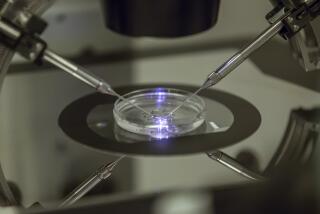BODY WATCH : The Wrong Sell? : It’s a new kind of health ‘insurance’: harvesting fetal blood cells in case a bone marrow transplant is needed later. But some ethicists say it’s exploitative.
- Share via
When new parents plan for their children’s futures, they usually think of college nest eggs and life insurance.
But several biomedical companies--hot on the trail of recent medical discoveries--are trying to convince parents of the need to provide for their children’s “biological” insurance.
For a price, they will collect and freeze blood cells drawn from the umbilical cord and placenta at birth. One Connecticut company, Biocyte Corp. of Stamford, says it has packed away in liquid nitrogen the cord blood from 200 to 300 babies.
Many scientists say cord-cell transplants promise to become an alternative to bone marrow transplants. Like bone marrow, fetal blood is rich in self-renewing cells, called stem cells, capable of spawning a complete array of blood and lymph cells.
And stored blood cells will also eliminate the time it takes to find a match. Because of a bone marrow donor shortage, the median time is 126 days.
Studies since 1989 have shown an ever-growing list of young patients for whom cord-cell transplants from siblings have halted, and at times cured, immune system and blood disorders, including such cancers as leukemia.
“It is a very effective means of transplantation, taking products from the birth of an infant that are ordinarily discarded,” says Dr. Eileen Gillan, a pediatric cancer specialist at the University of Connecticut Health Center in Farmington.
And, scientists say, the cells being transplanted may be not only equal to, but better than, bone marrow. Because they come from the immature immune system of a newborn, cord cells seem more flexible, grafting successfully where marrow cells of identical tissue type prove incompatible, Gillan says.
That could mean less of a problem getting a transplant to take when the donor and recipient are mismatched.
Ethicists and scientists argue against parents jumping on the cord-cell bandwagon, noting that most children will never need a transplant. In addition, there are still unknowns.
But Biocyte President Michael J. O’Brien says banking a child’s own blood means that a sick child’s parents would never have to mount a frantic search for a compatible donor.
The major complication that results from stranger donors--a reaction in which the transplanted cells reject the body into which they have been transfused--is obviated, he says.
Ethicists, citing the very small chance that a child will need a transplant, brand the selling of “biological” insurance as exploitative.
There are also what some scientists say are the unknowns.
Most people assume that getting their own stem cells is safer than getting a stranger’s, which won’t be identical genetically, says Dr. Paul R. McCurdy, who heads the blood resources program of the National Heart, Lung and Blood Institute, one of the National Institutes of Health. But they could be wrong, he adds. The very cause of a child’s leukemia may be encrypted and dormant within the original stem cells. A transplant “could be setting up a recurrence of the tumor.”
Another potential problem is introduced by the technique of winnowing plasma and other blood products from cord blood so that what remains is a small, space-saving, super-concentrated mixture of stem cells. Scientists still have no way to count stem cells, McCurdy says.
Although doctors currently perform successful transplants based on what works empirically, scientists do not know yet what quantity and ratio of blood components are needed for a successful transplant.
The federal government is preparing to award $20 million in grants and contracts in an effort to understand in detail what goes on when the body makes blood and immune cells. Also, the companies that are freezing stem cells are operating on their own, without direction from the U.S. Food and Drug Administration.
The FDA is preparing rules, “but the state of the art is so early” that the government has not been able to set down regulations, McCurdy says.
(BEGIN TEXT OF INFOBOX / INFOGRAPHIC)
Umbilical Cord-Cell Transplant
Umbilical cord-cell transplants promise to become an alternative to bone marrow transplants. Here’s how the technique works:
1. An obstetrician or a technician draws off 80 to 100 milliliters--about three ounces--of blood from a newborn’s discarded umbilical cord and attached placenta. (Researchers have been able to harvest up to 200 milliliters. But the highest amounts, in any case, are too small to have been tried successfully in adults, a drawback to wider use of cord transplants in anyone other than children at least for the moment.)
*
2. The blood is then screened for viability, sterility and infectious disease, and mixed with a preservative to prevent the formation of ice crystals. It is then refrigerated through a series of step-down temperatures until it is stored in a liquid nitrogen freezer at 196 degrees below zero Celsius. There it sits for years, awaiting a need to return from whence it came.
More to Read
Sign up for Essential California
The most important California stories and recommendations in your inbox every morning.
You may occasionally receive promotional content from the Los Angeles Times.













